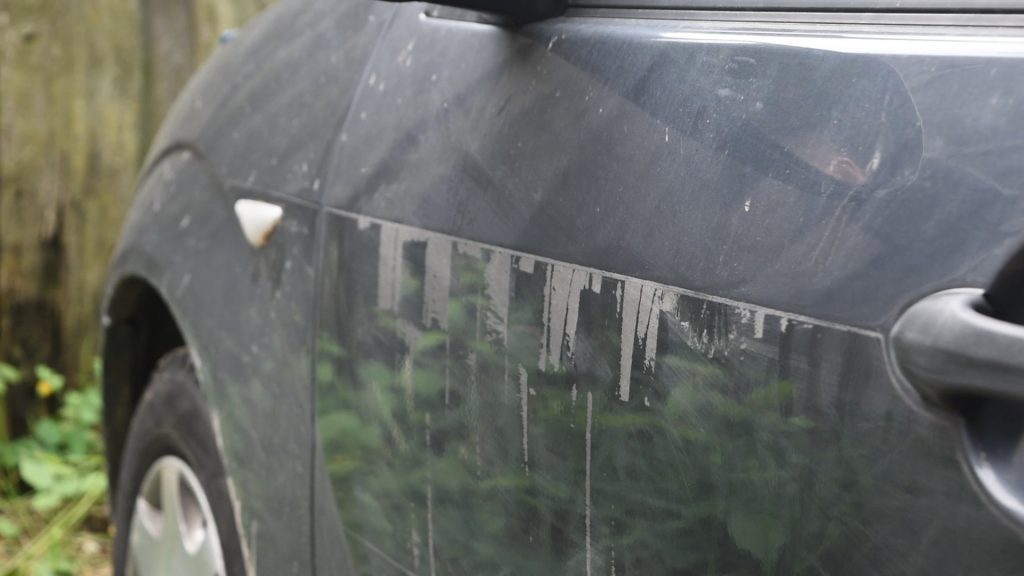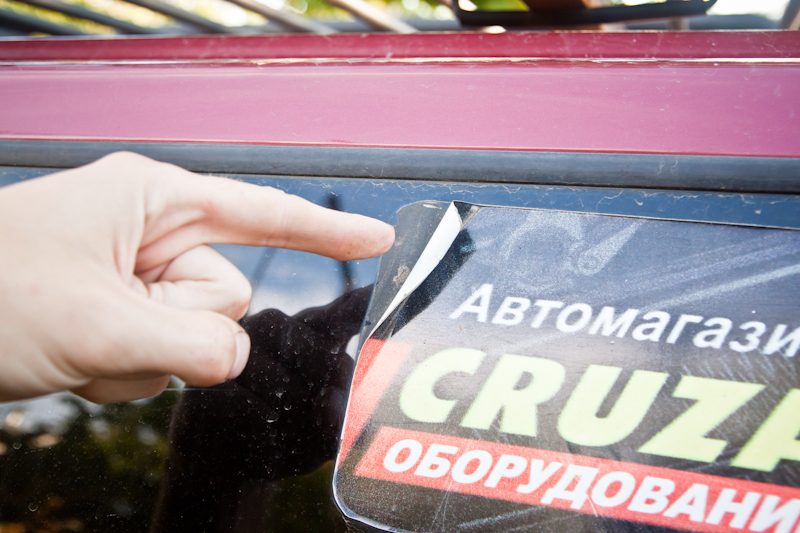
How to remove glue from the body?
Content
Some auxiliary elements of the body are attached to it with glue, so when they are eliminated or disassembled, glue residues very often remain. Removing these leftovers can be a real nightmare. It is possible to damage the paintwork, especially if the adhesive has already crystallized in the sun.
Thus, it is very important to know how to remove glue from the body using various methods in order to avoid complications in carrying out these works.
How to remove glue from the body?
To learn how to remove glue from the body, first, it is important to determine the type of glue you want to remove in order to choose a method that will do it easily and effectively. Vinyl adhesives can be removed easily by heating, while other materials for pasting require the use of special substances.

It should be remembered that it is very important to remove the remnants of the glue that remains on the surfaces of the elements used in the subsequent assembly of the vehicle assembly.
Some methods and techniques to remove glue from the body:
- When you're going to clean vinyl adhesive, the most effective method is to heat the component or decal with a hair dryer to melt the adhesive and lose adhesion. In the case of liquid vinyls, heating will not help to remove the adhesive film.
- Sometimes, in order to remove the remnants of a double-sided acrylic tape, it is necessary to cut off the glue with the help of some tool that has a certain cutting ability, for example a spatula. When performing this operation, you should be very careful not to scratch the surface, so it is recommended to use plastic spatulas and use it with moderate force and control.
- In order to remove the residues correctly, it is recommended to start from the corner and always pull in the same direction. To do this, you must complete the task with patience, using a moderate uniform degree of effort, and not make jerks.
After removing residues, often traces of glue remain on the surface. They must be removed if they affect the appearance of the part, or subsequent assembly. To find out how to remove this glue from the body, you need to determine what type of glue it is. Depending on this, the following methods can be used:
- Residues from vinyl glue are removed efficiently with a degreaser. Avoid using products such as аcetone or other aggressive solvents, as they can damage the paint or lower the brightness of the surface. In some cases, you can also use rags with alcohol as a means to remove glue residue.
- On the contrary, when the adhesive is left from double-sided tape, any degreaser or solvent is ineffective, therefore it is necessary to resort to using rubber or rubber discs, known in the workshops as vanilla or caramel discs (the smell is sweet, emitted when rubbing the surface. These discs do not damage the paint They are very effective and also serve to remove vinyl stickers.
- Finally, a grinding wheel can be used to remove small adhesive residue. Sometimes it is necessary to carry out sanding with sandpaper grit 2.000 - 4.000. Once the adhesive residue has been removed, a polishing process must be carried out to restore the original gloss of the paintwork.

Finally, the following methods can be applied to remove residual adhesives used in repairs:
- If it is an adhesive based on polyurethane foam or other adhesive materials, you need to use special products on the surface. These products may be specific to each adhesive or general purpose. In any case, if the residue of any of these adhesives is found during the implementation, and has not yet dried, it can be cleaned quickly with a non-aggressive cleaner.
- If these are residues of low adhesion glue used on certain substrates or surfaces (for example, windshield polyurethanes on non-primed surfaces), it is advisable to allow them to dry and, subsequently, to remove them with a plastic spatula.
- Finally, to remove residual glue or sealant present in some of the fasteners that are closed from access (fasteners placed in door panels, structural seams, etc.) and some parts of the car body, where the assembly was carried out by duplication (connections between the components of the and structural elements of the body), it is necessary to clean the surface with a brush or disc mounted on a tool. On the other hand, the glass sealant seams must be chiselled.
Materials required for work
Here is one of the options for how to remove superglue residues from the car body in a budget way. This will require:
- Dimexidum solution - you can buy it at any pharmacy;
- Necessarily medical or household rubber gloves (in medical it will be easier to do the job neatly, but they tear easily);
- A cotton swab wrapped around a wooden stick. If the spot of dried glue is small, then hygiene sticks, which are sold on every corner, are quite suitable;
- A small plastic or wooden scraper - you will need it to remove the softened glue (an orange stick may work if the motorist has a spouse - they are used by everyone who does their own manicure);
- Clean dry rags and clean water.
When working with Dimexide, you need to be careful so that the substance does not damage the respiratory tract. For this reason, it is best to do the work in a ventilated area. A mask will also do the trick.
The work is carried out as follows. The tampon is moistened with Dimexide, and the glue stain is gently rubbed. The substance acts on dried glue, softening it. When there is a feeling that it has softened, you need to use a scraper or dry rag. In this case, the main thing is not to dilute the glue on the body.

If the stain is large and thick, then the glue will have to be removed in layers. In the process of processing with Dimexide, the cotton swab must be changed so as not to rub the remnants of the glue. After removing all residues, the surface to be treated is washed off with water and wiped dry. Often whitish traces remain after processing. Basically, it is a thin film of glue that has not completely removed. By its composition, Dimexide does not affect the paintwork, but it is not recommended to work with it on plastic, since the product will be damaged by a chemical agent.
But in most cases, motorists are faced with the need to remove the remnants of a car sticker (for example, a 70 or "U" badge). All such accessories are made of vinyl, which is resistant to temperature extremes and moisture. In order for the sticker to be securely fixed on the surface, manufacturers use high-quality glue. In some cases, the sticker can last for more than three years. During this time, it will become so entrenched on the surface that it will be impossible to do without improvised means.
Of course, what materials a car owner will need depends on the method he uses. Basically, for high-quality performance of work, you may need:
- Clean rags;
- Clean warm water;
- Detergent for removing dirt on the body;
- Hair dryer (you can even use a household one - the main thing is to heat the glue base so that it becomes elastic);
- A plastic or wood scraper, with which you can gently pry off the edge of the sticker;
- Liquid for removing glue residues. You can use special products that are sold in auto accessories stores, gasoline, kerosene (but in no case with a solvent, so as not to damage the paintwork). Regardless of which product is chosen, it should not aggressively affect the paintwork of the car;
- Polishing materials - they will come in handy when, while removing the sticker on the body, slight abrasions of the glossy coating have formed;
- Personal safety equipment - gloves, goggles (if necessary), respirator or mask.
How to remove traces or fragments of glue from the body and glass elements of a car
After prolonged use of the sticker on the car, you need to use special methods to remove it. Moreover, there are several of these options. Regardless of the method chosen, a trace of the adhesive base may remain on the body or glass of the car. Removal of this substance for most car owners is a real headache, since the process of using an incorrectly selected cleaning agent simultaneously damages the paintwork or the glass becomes cloudy. Because of this, in some cases it is necessary to repaint the car or change the glass.

In this case, bodywork specialists recommend using different agents that chemically destroy the glue remnants, but do not affect the paintwork. Amateurs claim that gasoline, kerosene or degreasers, which are used before painting the body, will perfectly cope with this task.
It all depends on the material capabilities of the motorist. Regardless of which method of removing a foreign stain is chosen, after work, it is necessary to wash the body with water and soap or other detergent. This will remove any residual adhesive backing that is no longer adhering to the surface. After processing, the matt-colored body part is polished.
Common mistakes of car enthusiasts
As we have already paid attention to, an incorrect procedure for removing the adhesive base of the sticker can result in the car owner in subsequent repair work to restore the paintwork. These are the actions of motorists that will necessarily lead to damage to the car body:
- When using a building hair dryer, the maximum temperature is used, due to which varnish and paint deteriorate;
- In the process of removing a thick layer of glue base, a metal spatula or scraper is used (the paint is scratched);
- Chemicals are used that effectively corrode glue residues, but at the same time also aggressively affect the paintwork;
- In addition to chemical treatment, a building hair dryer is used (many people know that many chemical processes are enhanced by high temperatures).
These methods should be avoided as much as possible if, in addition to removing the sticker, the car owner also wants to preserve the car's paintwork. With careful handling of the body, there is much less chance of damaging the car to such an extent that a complete or partial repainting of the vehicle is required.
Conclusion
The use of adhesives in the automotive industry is very common, both for fixing parts and for repairing or installing certain auxiliary parts. The main problem with glue is that it will leave marks during application, so it is always important to know how to remove the glue from the body. This, however, simplifies the work of both the car enthusiast and the workshop professional and improves the efficiency of the process and the result of the work.
Here's a short video that tests a couple of tools to help remove residual adhesive backing from a sticker:
Questions and answers:
How to remove the adhesive from the tape from the car body. To do this, you can use sunflower oil (not necessarily some expensive one), dishwashing detergent, or an ordinary damp cloth. Under no circumstances should abrasive materials be used. They remove traces of adhesive tape, but with them, the gloss of the paintwork also goes away. Do not use acetone, nail polish remover, or similar substances.
How to remove hot melt glue from a car. Acetone solvent, white spirit and other solvents are effective for removing tempo adhesive. But in the case of body paintwork, they are extremely harmful. Therefore, it is better to warm up the stain with a hair dryer, and remove its remains with a dry cloth.
How to remove masking tape from a car. To remove such contaminants, you can use isopropyl alcohol (not methyl or ethyl alcohol, which is sold in pharmacies). You can also use kerosene, but for better confidence it is worth testing it on an invisible area of the paintwork, for example, under the hood or under the trunk lid .. If we talk about the products that are sold in auto chemical stores, then according to reviews, Profoam is a good option (1000-5000) ...
